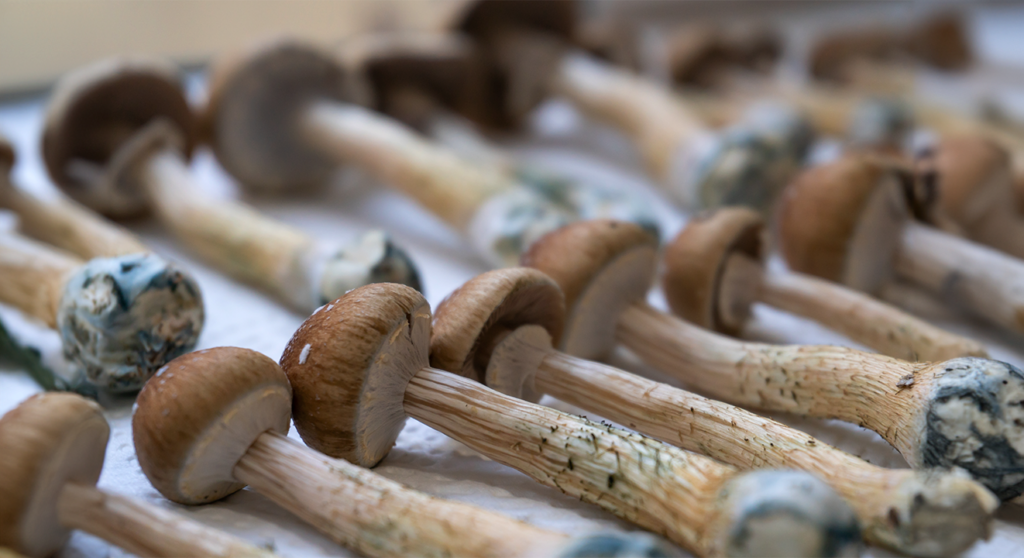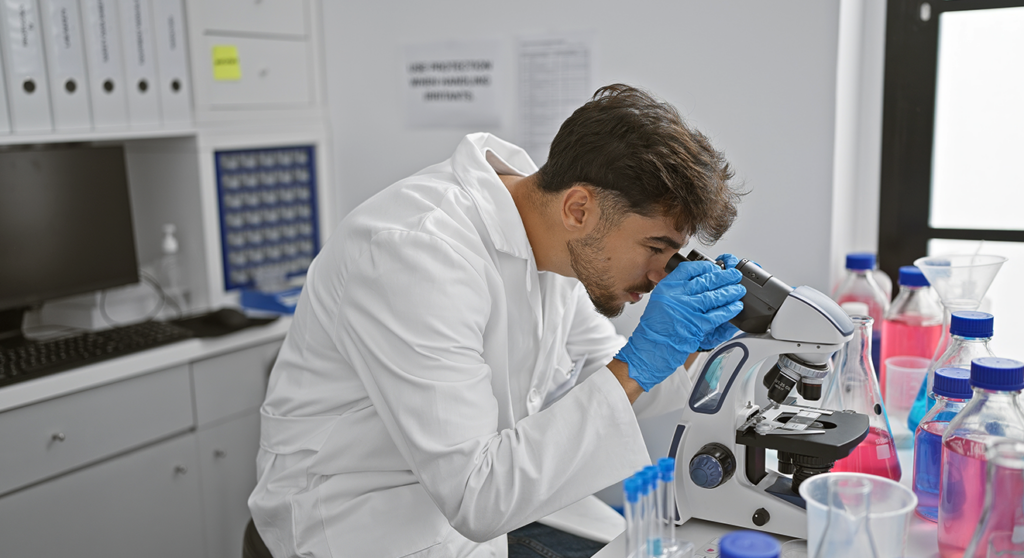
Generally, shrooms aren’t detectable in the body for very long, and testing for their use isn’t very common.
The primary method used to detect the use of magic mushrooms is specialized urine testing. If this type of test is conducted, the detection window is usually about 24 hours after a person’s last use. It’s also possible to perform a hair test for shroom use, but this isn’t common. Understanding these timelines and methods is necessary to address concerns related to drug abuse and ensure safety.
Need support overcoming mushroom addiction? Get started today
Shroom Half-Life & Its Impact in Your System
The term shrooms or magic mushrooms usually refers to psilocybin mushrooms, a group of hallucinogenic mushrooms. The drug in these mushrooms is their namesake, psilocybin, which turns into psilocin in the body. This then causes the effects associated with the mushroom.
Different types of mushrooms, specifically psilocybin-containing mushrooms, affect the body in varying degrees. The potency and effects can differ based on the mushroom species. For context, other hallucinogens such as LSD and PCP also induce hallucinations and alter perception, but their chemical structures and effects on the body are distinct.
Psilocin has an elimination half-life of about three hours. This is the time it takes for about half of the drug currently in a person’s system to be removed. It generally takes four to five half-lives for a drug to be at least 95% removed from a person’s system.
While under the effects of shrooms, a person will hallucinate. This means they will see and hear things that aren’t there. They will often feel a sense of euphoria and well-being. Negative effects can include stomach pain, nausea, headaches, fast or irregular heartbeat, rapid breathing, a “bad trip,” vomiting, facial flushing, sweating, and chills.
Shroom Drug Test Detection Timeline
Drug testing for shroom use isn’t very common, and the detection window for hallucinogenic mushroom use is usually fairly small. The following chart describes the types of tests that might be used to detect shroom use:
| Test Type | Detection Window | Reliability | Process | Potential for False Positives |
| Urine Testing | 24 Hours | Good | Noninvasive; private sample collection | Low |
| Hair Testing | Up to 90 Days | Mixed | Invasive; requires a hair sample | Moderate |
| Blood Testing | Few Hours | High | Invasive; blood draw required | Low |
| Saliva Testing | Few Hours | Moderate | Noninvasive; saliva sample collection | Low |
Urine Testing
A standard urine screening won’t typically detect shroom use. However, a person’s urine can be tested for shroom use, which is usually only done if there’s reason to suspect they’re experiencing the effects of mushrooms during the period the sample is being collected. This is in part due to the narrow detection window. After about 24 hours, most shroom use won’t be detectable via urine testing.
While it’s possible to test for shroom use via hair (described in the next subsection), federally regulated programs currently only collect and test urine. Urine testing is usually considered relatively noninvasive. It doesn’t require significant time from an individual and also doesn’t require any type of specialist to collect a sample. The collection process is painless and usually done privately in a restroom.
Urine tests are commonly used to detect substances such as opioids and amphetamines. These substances have different detection windows and metabolites, making them more easily detectable than shrooms.
Hair Testing
Hair follicles can be tested for the presence of hallucinogenic compounds, which might allow them to detect the use of shrooms. In ideal conditions, the detection window for this type of testing can be as long as 90 days. However, many conditions can reduce this detection window, including how a person cuts their hair.
Several factors can influence the reliability of hair follicle tests:
- Hair treatment: Chemical treatments such as dyeing, bleaching, or perming can alter the structure of the hair, potentially affecting the presence of drug metabolites.
- Hair growth rate: Individual differences in hair growth rates can impact the detection window. Slower hair growth may result in a shorter detectable period.
- Hair type and color: Different hair types and colors can absorb and retain metabolites differently, potentially leading to variations in test results.
- Environmental exposure: External contamination from environments where drugs are present can lead to false positives.
This type of testing isn’t very common. It can be expensive and requires a period of time between when a person uses drugs and the time it takes for their hair to grow out before a test can detect drug use of at least a few days. Collecting a hair sample isn’t typically painful, but it’s considered relatively invasive, as hair must be cut off an individual and taken for testing purposes.
Blood Testing
Blood tests are highly reliable and can detect shroom use within a few hours after ingestion. This type of test is invasive, requiring a blood draw, and is usually conducted in a medical setting. Blood tests have a low potential for false positives, making them a preferred method in some legal and medical situations.
Saliva Testing
Saliva tests are noninvasive and can detect shroom use within a few hours after ingestion. They are relatively easy to administer and are often used in situations requiring quick results. The detection window is short, and the potential for false positives is low, making saliva tests a useful tool in certain scenarios.
Notable Limitations
The reality is that it takes relatively specialized tests to detect magic mushroom use, and the most common type of test has a short detection window. While the reason for performing drug tests can vary, the general concern is usually that an individual is doing drugs in a way that might be unsafe during work hours or that they otherwise cannot control their drug use. Because shrooms are hallucinogenic and can cause significant mood changes, it will often be obvious when a person is under their effects.
Shrooms are harder to detect compared to other substances for several reasons:
- Short detection window: The metabolites of psilocybin, the active compound in shrooms, are quickly eliminated from the body, usually within 24 hours, making them difficult to detect with standard drug tests.
- Specialized tests required: Unlike opioids or amphetamines, which are commonly tested for in routine drug tests, detecting shrooms requires specialized tests that are not widely available.
- Psychedelic nature: The hallucinogenic effects of shrooms are temporary and can cause withdrawal symptoms and flashbacks, but these effects are not easily measured through drug tests. This makes it challenging to identify long-term use or dependence.
The most likely scenario in which a person will be tested for shroom use is when it’s already strongly suspected they are under the effects of shrooms and an organization wants to confirm it for legal reasons or for the sake of thoroughness. Random testing for shroom use would be uncommon. It would be a significant added expense for most organizations, and it’s unlikely to catch many individuals.

Factors That Can Impact Detection Time With Shrooms
The detection window of any drug can vary depending on the individual. The numbers discussed so far are general figures based on the standard person. A person’s metabolism, which is how quickly their body processes substances, can vary significantly. This variation can affect how long mushrooms remain detectable in their system.
Potential factors that can impact metabolism include the following:
- Age
- Sex
- Physical activity levels
- Hormone function
- Liver function
- Body composition
- Diet
- Hydration levels
- Genetic factors
The frequency with which a person uses a drug and the amount they use can also affect their detection window, with longer and heavier use often extending the detection window.
It’d be relatively rare for a fairly healthy individual to have a detection window significantly different than the norm. However, variation is possible. Variations are much more common in people with certain health conditions or who are taking medications that may alter their metabolism. These cases usually extend the length of a detection window.
Health Effects of Shroom
Magic mushrooms, or shrooms, primarily affect the brain and body through their active ingredient, psilocybin. When ingested, psilocybin converts to psilocin, which impacts serotonin receptors in the brain, leading to altered perception and mood changes.
Here are some more details about their physical and mental health effects:
Physical Effects
- Positive effects: Users often report feelings of euphoria, altered sensory perception, and a sense of interconnectedness.
- Negative effects: These can include nausea, vomiting, stomach pain, muscle weakness, and increased heart rate. Some users may also experience dizziness, chills, and sweating.
Mental Health Effects
- Positive effects: Some users report enhanced creativity, introspection, and spiritual experiences.
- Negative effects: Anxiety, paranoia, and confusion are common during a “bad trip.” In some cases, shrooms can exacerbate pre-existing mental health conditions, potentially leading to psychosis or severe panic attacks.
Understanding the full spectrum of the effects of magic mushrooms is crucial for users to manage their experiences and recognize when to seek help from a healthcare professional.
Impact of Shroom Use on Daily Life
Shroom use can significantly affect daily activities, work performance, and personal relationships.
Daily Activities and Work
- Impaired judgment: Under the influence, users may have difficulty concentrating, making decisions, and performing tasks that require fine motor skills.
- Reduced productivity: The lingering effects of a shroom trip can lead to decreased motivation and focus, impacting work performance.
Relationships
- Communication issues: Hallucinogenic experiences can alter how users interact with others, potentially leading to misunderstandings and conflicts.
- Isolation: Frequent use can result in withdrawal from social activities and strain relationships with family and friends.
Maintaining a balanced lifestyle is essential. Regular use of shrooms can disrupt physical and mental well-being.
Struggling with Hallucinogen Addiction? Do you need help?
Detox Methods for Shrooms
Detoxing from shrooms involves clearing the substance from the body and managing withdrawal symptoms. Natural detox strategies include maintaining proper hydration and nutrition: Drinking plenty of water and eating a balanced diet can help flush out toxins. Regular physical activity also boosts metabolism and expedites detoxification.
Support groups play a crucial role in this process, providing a community where individuals can share experiences and detox strategies, offering both emotional and practical support.
Inpatient and outpatient programs offer structured environments for detoxification. Inpatient programs provide intensive detox and therapy in a controlled setting, suitable for severe cases. In contrast, outpatient programs offer flexible treatment options that allow individuals to continue with daily responsibilities while receiving necessary support.
Consulting a healthcare professional is essential. They can provide tailored detox plans and monitor progress, ensuring a safe and effective detox process.
Addiction and Treatment
Recognizing and addressing shroom addiction is critical for long-term recovery. Signs of addiction include increased tolerance, inability to stop use, and continued use despite negative consequences. Withdrawal symptoms may include irritability, mood swings, and cravings.
Various treatment options are available, including Cognitive behavioral therapy (CBT), which helps individuals understand and change their behavior patterns related to shroom use. Comprehensive addiction treatment programs that include therapy, counseling, and support can be highly effective.
Treatment centers provide intensive, structured treatment for substance use disorder, while peer support groups offer shared experiences and coping strategies. Drug rehabilitation involves detox, therapy, and aftercare to support long-term recovery, addressing both the physical and psychological aspects of addiction.
Legal and Safety Considerations
The legal status of shrooms varies by region; in some areas, they’re classified as controlled substances, while others may allow limited use for research or medicinal purposes. It’s important to be aware of local laws and regulations regarding shroom use.
For safety, if choosing to use shrooms, do so in a safe environment with trusted individuals and avoid mixing with other substances. Seeking medical advice before using shrooms is crucial, especially if you have underlying health conditions.
If you’re concerned about a loved one’s shroom use, approach them with care and encourage them to seek professional help. Consult healthcare professionals for guidance on managing shroom use. By understanding these aspects, individuals can make informed decisions about shroom use and take necessary steps to ensure their well-being and safety.

Understanding Shroom Detection and Detox
In summary, knowing how long shrooms stay in your system and detox methods is crucial for recovery. Shrooms, mainly psilocybin-containing mushrooms, have a short detection window, but various factors like metabolism and frequency of use can influence this.
Drug tests for shrooms, such as urine and hair follicle tests, are not common but can detect their presence. Awareness of shrooms’ health effects and potential addiction is helpful. Detox methods and professional advice can support effective cleansing.
If you or a loved one is struggling with shroom use, consult a healthcare professional or consider joining support groups and treatment programs at Boca Recovery Center. Prioritizing wellness and staying informed can help manage the risks associated with psychedelic mushroom use.
- Pharmacokinetics of escalating doses of oral psilocybin in healthy adults. Brown RT, Nicholas CR, Cozzi NV, et al. Clinical Pharmacokinetics. 2017;56(12):1543-1554.
- Psilocybin (magic mushrooms). Australian ADF. Published November 22, 2023. Accessed February 17, 2024.
- Metabolism of psilocybin and psilocin: clinical and forensic toxicological relevance. Dinis-Oliveira RJ. Drug metabolism reviews. 2017;49(1):84-91.
- Metabolism. Better Health Channel. Published August 12, 2023. Accessed February 17, 2024.
- Chapter 33 - Abuse of magic mushroom, peyote cactus, LSD, khat, and volatiles. Dasgupta A. ScienceDirect. Published January 1, 2019. Accessed February 17, 2024.
- Drug testing resources. Substance Abuse and Mental Health Services Administration. Published February 17, 2023. Accessed February 17, 2024.



